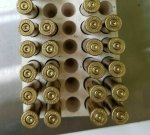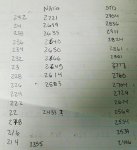A sample of one won't give you useful information. It is more likely to throw you off track.
If you did a group of five - ten would be better - at each charge weight and took the average of each group, you would likely see a steady increase upward as you increase the charge until you begin to approach the point of dangerous pressure. On the other hand, the first sign could be a very loud Boom with scattered parts. Velocity is not really what you look for with the chronograph. You're really looking to measure the variability of velocity.
What you are probably seeing is that normal upward progression but with a high standard deviation. It might be that the bullet / powder combination just isn't the best but for all I know it might be the combination of choice of shooters much better than I. It could also be some other variability. Uniformity is key to accuracy.
One variable is two different brass headstamps. Also, military brass usually is thicker, meaning less case volume, meaning you can reach maximum safe pressure with a lower powder charge. The brass on the right has 5.56x45 on the headstamps. That doesn't mean it is a military brass, but it could be.



